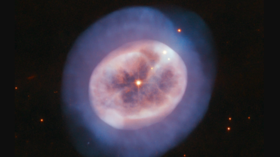Hubble captures hypnotizing PHOTO of distant planetary nebula

The Hubble Space Telescope is the gift that keeps on giving, as the international team operating it has once again shared a truly mesmerizing image from space, this time of a planetary nebula.
A rare sight to capture on film, this particular object, named NGC 2022, likely won’t last long (cosmically speaking) as the ageing star at its center appears to have already expelled a huge amount of its material, forming the two shells visible in the image.
Although it looks more like an entity seen through a microscope than a telescope, this rounded object, named NGC 2022, is a vast orb of gas in space, cast off by an ageing star. Credit: @ESA / @Hubble_Space / @NASA R. Wade https://t.co/zOVXp12mnVpic.twitter.com/99opx0kIoi
— HUBBLE (@HUBBLE_space) August 12, 2019
Found in the constellation of Orion (the Hunter) 8,213 light-years away from Earth, NGC 2022 has likely exhausted most of its hydrogen reserves and has already expanded and began glowing red, indicating that the end is nigh as the remaining gas is expelled.
Meanwhile, the star’s core shrinks and grows increasingly hotter, emitting vast amounts of ultraviolet light which illuminates the expelled gases, giving them a haunting but beautiful glow.
Also on rt.com Hubble captures double-star system’s spectacular cosmic fireworks (IMAGE)Known as a planetary nebula, despite having nothing whatsoever to do with planets, the name actually comes from the rounded and somewhat planet-like appearance of these objects when they were first spotted by rudimentary telescopes many years ago. NGC 2022 was first discovered in 1785 by the famous British astronomer William Herschel.
Such planetary nebulae don’t typically last long, by cosmic standards at least, spreading out in a matter of roughly ten thousand years before slowly dissipating and leaving behind a white dwarf in their wake.
Think your friends would be interested? Share this story!














